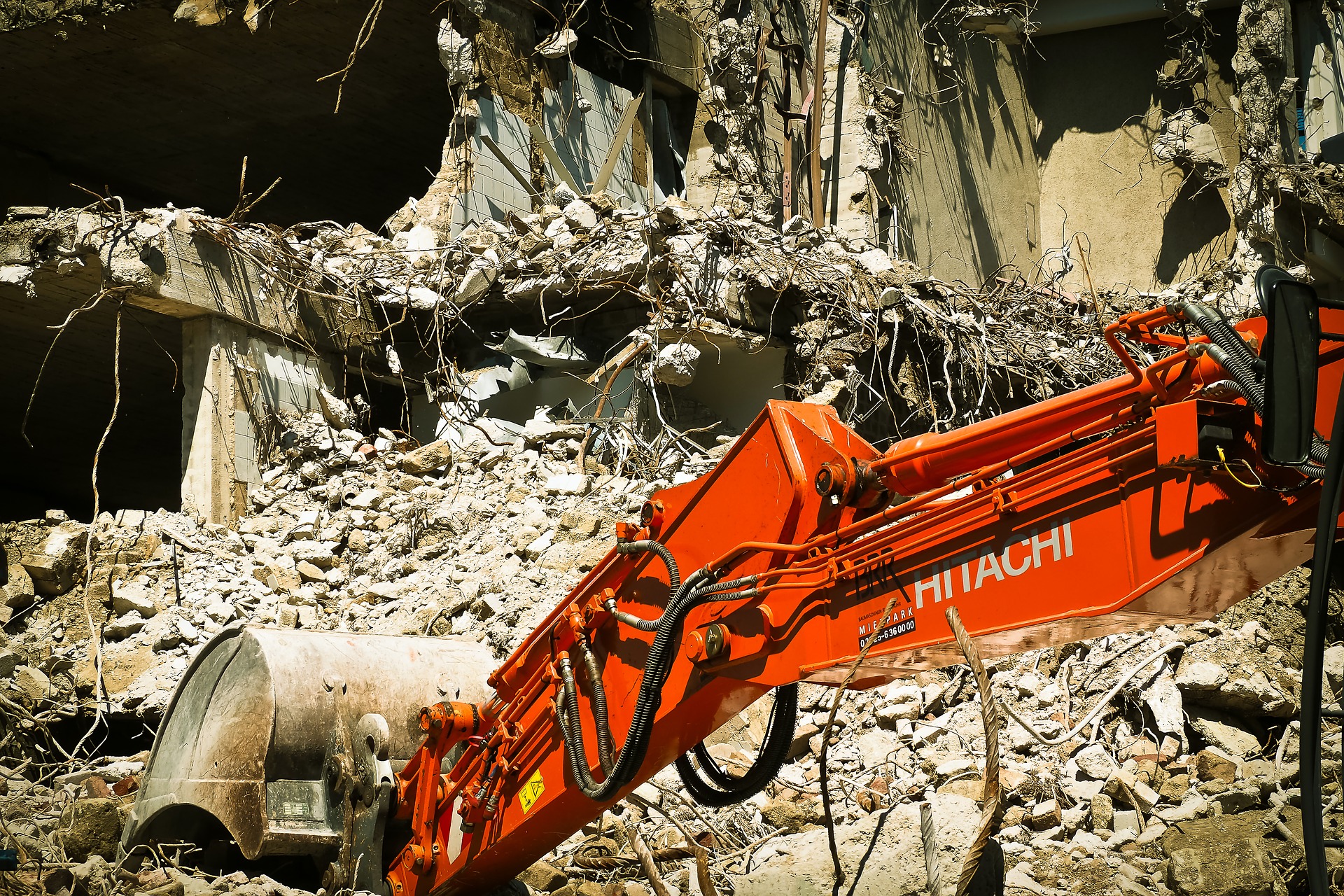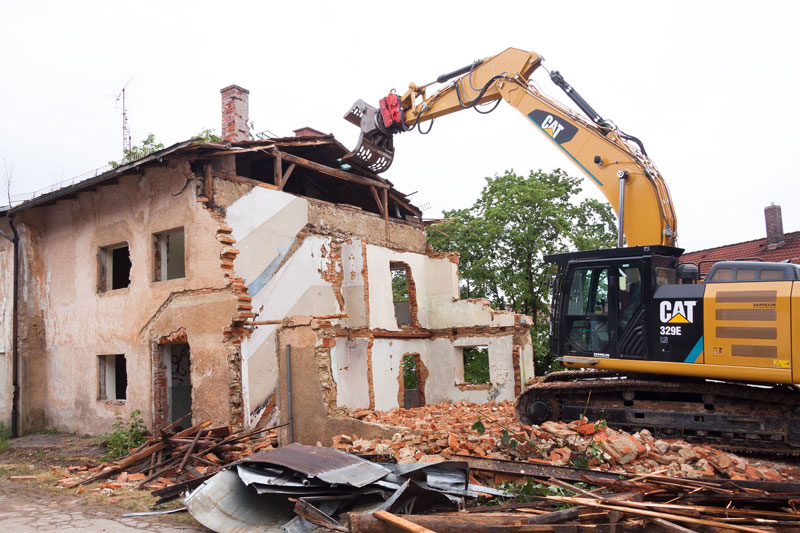16 Things to consider before demolishing a building
Demolition is the process of dismantling a building by pre-planned or controlled methods. If you have bought or are buying a plot of land that has an existing dwelling on it that is, for whatever reason, not worth restoring, you will probably want to look into demolishing it. In this article we outline some key things to consider before demolishing a building. First let’s look at the some different ways to to demolish a building.
Way to Demolish a Building
There a few different ways to demolish a building depending on the location, building materials, purpose of demolition, and how the debris is going to be disposed of. It’s important to get the advice of an expert to help you decide the best method.
Implosion
This is a dramatic (and actually not very common) way to demolish usually a large structure in built-up urban areas. Using explosives, the building is caused to collapse in on itself from the inside out.
Excavator or High Reach Arm
This is often used on higher buildings and involves a base machine fitted with a long demolition arm, which is used to break up the building from the top down. This is considered to be safer than the traditional wrecking ball method and is used on reinforced concrete, masonry, steel and mixed-material structures.
Wrecking Ball
This is a common method for demolition using a wrecking ball weighing up to 12,000 pounds, which works like a pendulum. The ball is usually suspended from a crane and dropped onto or swung into the structure. This method must be carried out by highly experienced crane operators as an uncontrolled swing can tip the crane. This method also creates a lot of dust, vibration and noise.

Selective Demolition
This is perhaps the most eco-friendly method and is gaining in popularity these days. It involves removing specific sections and taking materials out bit by bit in the hope of re-using or recycling them. As the building is demolished in parts, this method can be more time consuming.
There is quite a lot to consider when it comes to demolishing a building so it’s important to have a clear strategy and avoid unnecessary extra issues and costs later. It is important to use highly trained experts for your demolition who will consider the weather conditions, materials, mass, physics, managing debris, etc.
Here is our list of 16 Things to Consider Before Demolishing A Building:
1. Planning permission to demolish
Demolition is not an activity you can hide very easily! It’s worth making sure you have the correct paperwork. In Auckland, building consent is not usually required to demolish a stand-alone (detached) building which is no more than three-storeys high (section 42A of the Building Act, Schedule 1). If your building is a ‘character’ or ‘heritage’ building you should contact your local council for approval. We recommend that you double check with Auckland Council Planning team to see whether you require consent.
2. Building survey
This is definitely one to think about before demolishing a building! Experts will examine the different characteristics of your building, such as materials, building function, construction type, condition, drainage conditions, traffic conditions, building codes, and location and community. This will help them decide on a suitable plan of action.
3. Trees
If you have trees on the property which may be affected by the demolition, make sure you employ a qualified & Expert arborist
4. Spa or swimming pools
If you plan on retaining the pool, check that any fencing is not affected by the demolition or removal of buildings. You should also apply to remove your pool from the council’s register.
5. Rights of way
Check that there is sufficient access available and no likelihood of damage to other properties (see section 4(j) of the Building Act 2004).
6. Power, gas, and water
Make sure you terminate the services and disconnect power, gas and water supplies according to regulations before demolishing your building. You should consider contacting the relevant companies to inform them of the extent of your work. If consent is required for your demolition, you will be expected to supply a certificate confirming this on completion of your project.
7. Asbestos
Another essential before demolishing a building – This should be a major consideration early in your demolition planning, especially if the building is more than 20 years old. If you suspect asbestos, contact a specialist team to carry out an inspection. Do not attempt to inspect or remove asbestos yourself as airborne particles are extremely dangerous to you and your surrounding neighbours. Our sister company Ambient Civil offers a one-stop asbestos inspection, removal, and replacement service. See also a guide to asbestos here.
See our Complete NZ Asbestos Guide
8. Planning permission for relocation of building
If you intend to move a building to another site, a separate consent is required.
9. Planning permission for replacement dwelling
Ensure you get the correct permissions for your replacement dwelling.
10. Warn the neighbours!
Be considerate and let your neighbours know in advance that you’ll be making a bit of noise and mess. With them on side, you eliminate that extra headache of dealing with their complaints and hostility and you ensure smooth relations going forward.
11. Attached and surrounding buildings
If your property is attached to other buildings, you will need to get consent for your demolition before starting. It is also important to consider nearby building as there can be risk of damage or disruption to these.
12. Check the Building code
It is important to do this as a matter of course before demolishing a building to make sure that you are doing everything by the book and won’t have issues further down the line. Have peace of mind that you’ve checked all the boxes.
13. Budget considerations
There are lots of variables and unknowns when it comes to a building demolition. It is worth having at least a 10% contingency for these things.
14. Safety and Security
The demolition team will restrict public access to the area by putting up a secure temporary fence or hoardings. They will identify potential hazards such as flammable or radioactive materials and exposure to noise and dust.
15. Environment
Before demolishing a building, think about how you will control silt runoff, noise, and dust generated by the demolition work.
16. Disposing of materials
Get professional advice for the best way to dispose of the hazardous building materials such as asbestos and flammable materials. Many materials and items can be re-used or recycled. Speak to your demolition team for advice regarding your specific building and location.
Anything we’ve missed? If you have anything to add to this list, please let us know!
We’d also love to hear your own demolition experiences! Share them in the comments below or visit our Facebook page.
For more information about demolishing your residential or commercial building, contact the Ambient Construction team.





